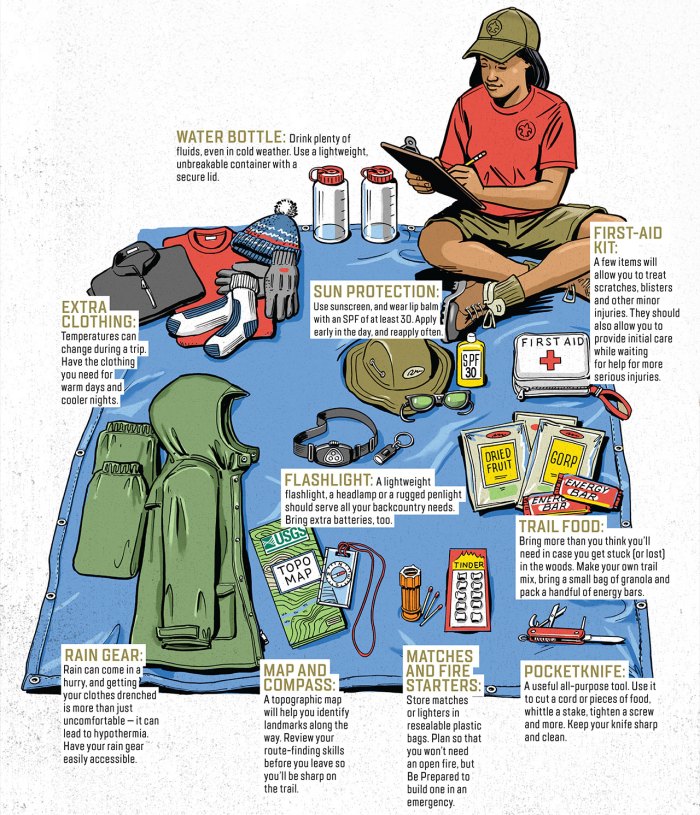Every Packing List Starts With the 10 Scout Basic Outdoor Essentials

You’re going on your first camping trip or backpacking trek. What should you bring? Every packing list starts with these 10 items, and they’re called “essentials” for a reason. Then you’ll want to add other items depending on the outing.
- Download a checklist for a warm-weather outing
- Download a checklist for a cold-weather outing
- Download a checklist for a paddling trip
- Download a checklist for a bicycling trip
THE 10 SCOUT OUTDOOR ESSENTIALS
The Scout Basic Essentials call for the following ten items. These items can help you stay comfortable, safe and prepared:
1. A pocketknife or multitool can be handy in a wide variety of situations. Use it to cut a cord or pieces of food, whittle a stake, tighten a screw and more. Keep your knife sharp and clean, and don’t forget to first earn your Whittling Chip (for older Cub Scouts) or Totin’ Chip (for Boy Scouts).
2. A first-aid kit can be a lifesaver. Literally. A few items will allow you to treat scratches, blisters and other minor injuries. They should also allow you to provide initial care while waiting for help for more serious injuries.
3. Bring extra clothing to match the weather. Temperatures can change during a trip. Have the clothing you need for warm days and cooler nights. Multiple layers are better than a single massive jacket, because layered clothing is adaptable to a wide range of temperatures.
4. Rain gear is very important. Rain can come in a hurry, and getting your clothes drenched is more than just uncomfortable, it can lead to hypothermia, a potentially fatal condition. Have your rain gear easily accessible.
5. A lightweight flashlight, headlamp or a rugged penlight is important for finding your way in the dark. Bring extra batteries, too.
6. Trail food is good for maintaining your energy. Make your own trail mix, bring a small bag of granola and pack a handful of energy bars. Bring more than you think you’ll need in case you get stuck (or lost) in the woods.
7. Water can prevent dehydration, heat exhaustion and heatstroke. Drink plenty of fluids, even in cold weather. Use a lightweight, unbreakable container with a secure lid.
8. Matches and fire starters may be used to light fires for heat, or for signaling for help. Store matches or lighters in resealable plastic bags. You may not plan to need an open fire, but Be Prepared to build one in an emergency.
9. Sun protection might include sunblock, sunglasses, lip balm and a wide-brimmed hat. Look for an SPF of at least 30. Apply early in the day, and reapply often.
10. A map and compass are probably the most important tools you can carry in case you get lost. A topographic map will help you identify landmarks along the way. Review your route-finding skills before you leave so you’ll be sharp on the trail.
It’s a good idea to bring a daypack for your Scout Essentials, so you can grab it and go if you’re hiking during the campout.
CLOTHING
You should also pack clothing matched to the season. Check the weather for where you’re going to camp. It might be warm where you live, but the temperatures might be dropping where you’re going.
SLEEPING
Here are some items you may need at night, depending on the outing:
- Tent
- Sleeping bag
- Sleeping pad
- Ground cloth
- Pillow
KEEPING CLEAN
Here are some hygiene and toiletry items you may want to pack, depending on the outing:
- Toothbrush
- Toothpaste
- Dental floss
- Soap
- Comb
- Waterless hand cleaner
- Small towel
- Washcloth
- Toilet paper
- Trowel for digging cathole latrines
COOKING AND EATING
Here are some cooking and eating items you may want to pack, depending on the outing:
- Mess kit
- Large plastic cereal bowl or kitchen storage bowl
- Spoon
- Cup or insulated mug
- Water treatment system
- Backpacking stove with fuel
- Large pot and lid (2.5- or 3-quart size)
- Small pot and lid (1.5- or 2-quart size)
- Lightweight frying pan (10 to 12 inches in diameter)
- For melting snow, add 1 large pot and lid (6 to 10 quarts)
- Hot-pot tongs
EXTRAS
Here are some extras you may want to pack, depending on the outing:
- Watch
- Camera
- Notebook
- Pen or pencil
- Sunglasses
- Small musical instrument
- Swimsuit
- Gloves
- Whistle
- Nylon cord
- Insect repellent
- Repair kit
- Hiking stick or trekking poles
- Binoculars
- Fishing gear
- Animal identification books, plant keys, geological studies, star charts or other guides
For car-camping where your campsite won’t be far from where you park, you can carry everything in a duffle bag. If you camp often, you’ll want to invest in a backpack so you can venture into the backcountry with all your gear.
needs water cleaning tablets.
Good job
Nice
We really don’t need a pot for melting snow on the WARM weather checklist… 🙂
Check out the Camping Checklist app on the Amazon app store.
Depending on the area in which you are trekking as you climb to higher elevations one may come across snow. However I do agree that this item may not be needed since there are other items that can be used instead.
The first time I saw snow in my life was in Utah in July!
I’m going on the Klondike this weekend what do you guys recommend
im a boyscout and i love this webpage
j
What about the Boy Scout Handbook? That is definitely an essential.
I agree
Ok so I’m helping with a cub camp I’m pretty sure this will get me through the camp. We leave Saturday and come back Sunday morning.